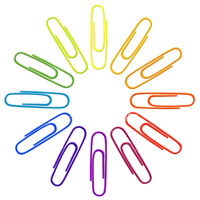Yesterday morning, I shared an article from Small Fuel on Business Cards. Over the last 5 years, I have always had custom designed business cards and I stumbled across the power of the color red.
I even did an informal study with people presenting two of my cards, one red and the other not red. I would ask them to pick the card they liked best and 80% would select the red business card!
To find out why and how important color is in your marketing, read this from Small Fuel:

Marketing by Color: Don’t Try To Sell Blue Potatoes

The colors you use for your logo, your business card, your web design and even your storefront display influence consumers – sometimes very strongly.
For example, what colors do you associate with a spooky night? Most likely, you’ll choose black, shades of gray and maybe a little silver or even orange. Haunted evenings generally don’t come in vivid blues and fresh greens, after all.
Here’s another example: Think about Coca Cola. What color jumps to mind? Most people choose red, because Coca Cola has associated that color with their brand image. Their logo is red, their cans are red and everything about the soda giant seems to be red.
You would most likely wince if you tried to associate the color green and Coca Cola together.
Read more to find out how you can use the power of color psychology to your advantage.
The Power of Color
Color psychology exists, and it’s a fairly complex field of study, too. It looks at which colors we prefer and why. It explores color and memory recall. It examines the impact of certain colors on both our physical and emotional state.
Harveys fast food restaurants, for example, use orange in their color branding because orange often stimulates appetite. Banks like to use blue in their themes, because people prefer blue over most colors and also because blue is commonly associated with trust and security.
When building your startup business or when considering an image overhaul of an existing business, put thought into color palettes and selections that will help your brand image. Mismatching color and brand can actually influence consumer perception in a negative way and cost you sales.
Trying to Sell Blue Potatoes
Here’s another example: everyone knows what a potato is—a root vegetable with white or red skin. We mash them into white fluffy clouds, slice them into scalloped casseroles and grate them into patties. We know that potatoes are white inside.
Enter the blue potato, a fantastic variety that mashes, slices, bakes and fries just as nicely as its snowy counterpart. It even has possible antioxidant potential.
To a certain enterprising company, this seemed like a lucrative business opportunity.
Did blue potato sales skyrocket? No. Did people rush to the stores for blue potatoes? Nope. Did the blue potato become a household staple? Nope. If it weren’t for their novelty factor and a few cooks with exploratory minds, these potatoes would never have sold at all.
The reason is that people don’t associate the color blue with potatoes.
In fact, they may go so far as to perceive blue potatoes as tasting bad, being inedible or even being poison for human consumption. The notion of a blue potato is so foreign that consumers don’t embrace the blue potato at all.
Do you want your business to become a blue potato?
Associated Meanings of Color
Spend some time thinking of potential color choices that reflect the emotion that you’d like people to have when they see your brand image. Color can have strong emotional impact that heightens the selling potential of your product or service.
Color can help memory recall as well. When you’re hot, thirsty and want something cold to drink, your memory of a color association might make you reach for that red can of Coke and pass over other brand names you don’t recognize easily. You remember that red means Coke.
Likewise, your company colors can help people remember your product or service and choose you over the competition. The specific colors you choose enhance the feelings a person has about your business, too.
To help you think of good colors for your logo, your web design or your business image, here are some common colors and their associated meanings:
Red – Energy, attention, passion, danger, debt, halt
Blue – Trust, security, peace, open, stability
Green – Freshness, growth, vitality, calm, wealth, prestige
Yellow – Light, optimism, motivation, warmth, positive
Purple – Sophistication, royalty, sentimentality, mystery, spirituality
Pink – Energy, fun, youth, excitement, affection, romance, sentimentality
Orange – Fun, vitality, youth, health, exuberance
Brown – Stability, earth, durability, dirty
Black – Power, class, seriousness, drama, sophistication, boldness
White – Purity, peace, cleanliness, freshness
A good rule of thumb is to choose one dominant color and only one or two accent colors for your logo or brand image. Accent colors should complement the main color and enhance its appeal as much as possible. Use them sparingly, as they should be secondary elements of the impact.
With a good choice of color, you can build a more effective image for your business and enhance your marketing potential - unless you want your business to be like blue potatoes, of course.
Author’s Note: Color meanings are not universal. Culture, events, industries and more affect the way we associate meanings with color.
For the purpose of our target audience, this post focuses on American culture.
Sphere: Related Content












No comments:
Post a Comment